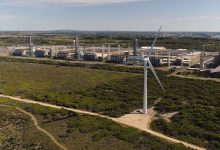Copper Demand under Pressure Due to Green Deal
The world’s largest economies are committed to reducing carbon emissions by diminishing their reliance on fossil fuels. They are building solar panels and wind turbines to make renewables their primary source of energy, and we can add electric cars to the list. However, all these ambitions require significant volumes of copper, a metal whose electrical conductivity makes it indispensable in the production of green technologies. But the new green revolution, which will gain momentum in the coming years, comes amid a shortage of copper production.
Copper demand was under pressure in 2022 amid political tensions, economic slowdowns in the US and Europe and anti-Covid measures taken by China. The red metal is now trading at around $8,300/tonne, after the price fell more than 20% from its 2022 peak in March. However, demand is set to grow in the medium term, while supply cannot keep up. Under these conditions, Goldman Sachs analysts expect the price of copper to reach $11,000/tonne by the end of 2023.
Green technologies strain demand
The global transition to clean energy is moving fast, and as demand for green technologies grows, more and more copper is needed.
Renewable energy plants require on average 8 to 12 times more copper than fossil fuel forms of energy generation, and electric vehicles consume 3-4 times more copper than an internal combustion engine vehicle. Current prospects for copper supply in the coming years are well below demand, as copper mines usually take more than a decade to develop, and relatively low commodity prices have discouraged investment in recent years.
“Quite frankly, this shortfall will have a dramatic impact on our ability to make the infrastructure needed for the energy transition – such as wind turbines, EVs and charging stations,” says Kate Southwell, General Counsel at Pala Investments, an investment company focused on raw materials needed to decarbonise. “Copper cannot be easily substituted in these uses so it is highly likely to see cost increases that will ultimately be borne by consumers and OEMs.”
Since the severe financial crisis that began in 2008, many mining companies have focused their investments on short-term projects to maximise profits. Because copper prices have been relatively low, and opening new mines requires billions of dollars of upfront investment, copper mining has not been a priority, except for a few boom years in the early 2010s.
Romania, in last place in Europe in the exploitation of own resources
Romania, despite being a country with significant copper ore reserves, the largest in Europe, only makes little use of this advantage. Canada’s Frasier Institute, recognized for its assessments of mining business opportunities around the world, showed in 2021 that out of 112 countries, Romania ranked 109th. Moreover, in terms of the exploitation of its own resources, Romania ranked last in Europe.
Currently, Romania produces around 55,000 tonnes of copper ore annually from the Rosia Poieni mine, owned by the state-owned company Cupru Min, and Baita, controlled by the British company Vast Resources. The largest quantity, over 50,000 tonnes, is provided by Cupru Min, which holds about 60% of Romania’s reserves.
Last spring, Economy Minister Florin Spataru brought back to public attention Romania’s intention to build a copper ore processing plant after the non-ferrous metallurgy was destroyed more than 15 years ago. However, under current conditions, the construction of a processing plant is not economically justified, given that a minimum quantity of 120,000 tonnes needs to be processed annually for such a plant to be even close to being profitable. Another option would be to repatriate the copper resulting from refining the concentrate, experts say, but this is not being considered by the authorities.
For years, what Cupru Min extracts goes to China, and in addition to the quantities of copper that Romania’s economy loses, the other metals that result from refining the ore can also be added to the list of losses: selenium and tellurium, two vital elements for rocket engines and sub-assemblies that require materials with high temperature resistance, gold, and silver.
For example, the Phoenix Copper Smelter in Baia Mare used to produce 40,000 tonnes of copper per year, 12 tonnes of gold and 120 tonnes of silver per year, but it was all destroyed. In addition, Ampelum Zlatna used to produce 15,000 tonnes of copper per year, but this plant has also disappeared.
50,000 tons of ore for sale
Cupru Min sent its copper ore production to China in 2021 and 2022 through Trafigura Group Pte. Ltd. of Singapore, one of the world’s largest players in metals and energy trading.
For contracting the 2023 production, Cupru Min organised a new international tender in November 2022, and the opening of bids took place in mid-December last year.
The winner of the 50,000 tonnes of copper ore has not yet been announced.
Still waiting for mining to reopen
Moldomin, owner of about 30% of Romania’s copper concentrate reserves (approx. 200 million tonnes), was sold in 2021 to Turkey’s largest mining company, Eti Bakir.
But reopening mining here also raises a legislative issue. A new mining law was enacted in 2020, but although some time has passed since then, the National Agency for Mineral Resources (NAMR) has not adopted the methodological rules for its implementation. Among other things, they should also regulate the procedure for reopening closed mining operations.
Estimated shortfall of 50 million tonnes
While Romania has significant deposits but is not exploiting them to their true potential, Glencore, one of the world’s largest dealers of non-ferrous concentrates, is now looking at developing the huge El Pachon mine in Argentina.
Glencore CEO Gary Nagle forecasts a ‘huge shortfall’ of copper, which could reach a cumulative 50 million tonnes between 2022 and 2030. Even now, despite concerns about a global recession, the balance between supply and demand remains tight. Quantities of copper sold on international exchanges reach record low levels, covering only a few days of global consumption.
Large mines reduce production
According to the International Copper Study Group (ICSG), only two major copper mines have been opened between 2017 and 2021.
Currently, two greenfield projects, Kamoa Kakula in the Democratic Republic of Congo and the Quellaveco mine in Peru, are increasing production, but this growth is offset by operational problems faced by other major mines around the world.
In Chile, the world’s largest copper producer, production will fall by 5.8% in 2022, according to government estimates. Chile’s state-owned Codelco said production fell in the first nine months of 2022 and will fall further in 2023.
In December, Panama’s government ordered Canada’s First Quantum Minerals to halt operations at its Cobre Panama copper mine after it failed to agree on royalties under a new contract. Local community protests in Peru are also disrupting copper production and supplies.
Russia opens up a huge deposit
In Russia, the giant Udokan Сopper project is scheduled to start production this year, with an estimated annual extraction of 135,000 tonnes of copper ore.
With ore reserves of over 26 million tonnes, Udokan is one of the largest deposits globally. Located in Russia’s Far East, near the border with China, the deposit is ideally positioned to transport the metal to a country that accounts for more than half of the world’s copper consumption.
China, the big beneficiary of the Udokan deposit
While Europe is postponing some of its green energy projects due to economic problems caused by higher oil and gas prices, China is on track to achieve net zero emissions by 2060.
This country is already the world’s largest producer of electric vehicles, solar panels, and electric batteries. The country’s development plans include increasing renewable energy capacity and increasing the share of electric vehicles in total car sales.
These initiatives will require additional copper and the Udokan deposit is ready to meet China’s growing demand.






